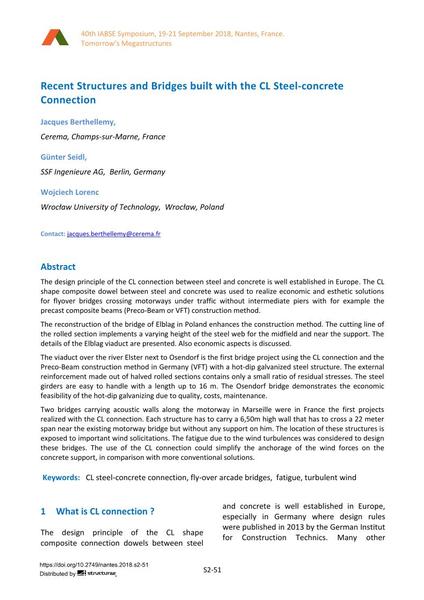Recent Structures and Bridges built with the CL Steel-concrete Connection

|
|
|||||||||||
Bibliographic Details
| Author(s): |
Jacques Berthellemy
(Cerema, Champs-sur-Marne, France)
Günter Seidl (SSF Ingenieure AG, Berlin, Germany) Wojciech Lorenc (Wrocław University of Technology, Wrocław, Poland) |
||||
|---|---|---|---|---|---|
| Medium: | conference paper | ||||
| Language(s): | English | ||||
| Conference: | IABSE Symposium: Tomorrow’s Megastructures, Nantes, France, 19-21 September 2018 | ||||
| Published in: | IABSE Symposium Nantes 2018 | ||||
|
|||||
| Page(s): | S2-51 | ||||
| Total no. of pages: | 9 | ||||
| DOI: | 10.2749/nantes.2018.s2-51 | ||||
| Abstract: |
The design principle of the CL connection between steel and concrete is well established in Europe. The CL shape composite dowel between steel and concrete was used to realize economic and esthetic solutions for flyover bridges crossing motorways under traffic without intermediate piers with for example the precast composite beams (Preco-Beam or VFT) construction method. The reconstruction of the bridge of Elblag in Poland enhances the construction method. The cutting line of the rolled section implements a varying height of the steel web for the midfield and near the support. The details of the Elblag viaduct are presented. Also economic aspects is discussed. The viaduct over the river Elster next to Osendorf is the first bridge project using the CL connection and the Preco-Beam construction method in Germany (VFT) with a hot-dip galvanized steel structure. The external reinforcement made out of halved rolled sections contains only a small ratio of residual stresses. The steel girders are easy to handle with a length up to 16 m. The Osendorf bridge demonstrates the economic feasibility of the hot-dip galvanizing due to quality, costs, maintenance. Two bridges carrying acoustic walls along the motorway in Marseille were in France the first projects realized with the CL connection. Each structure has to carry a 6,50m high wall that has to cross a 22 meter span near the existing motorway bridge but without any support on him. The location of these structures is exposed to important wind solicitations. The fatigue due to the wind turbulences was considered to design these bridges. The use of the CL connection could simplify the anchorage of the wind forces on the concrete support, in comparison with more conventional solutions. |
||||
| Keywords: |
fatigue CL steel-concrete connection fly-over arcade bridges turbulent wind
|
||||
